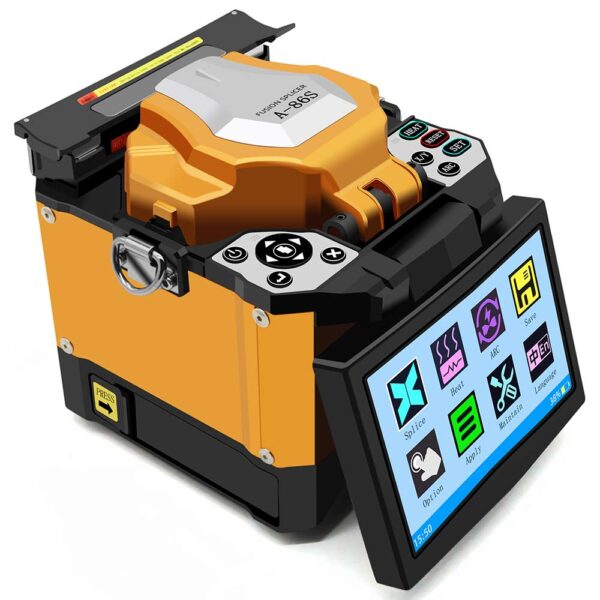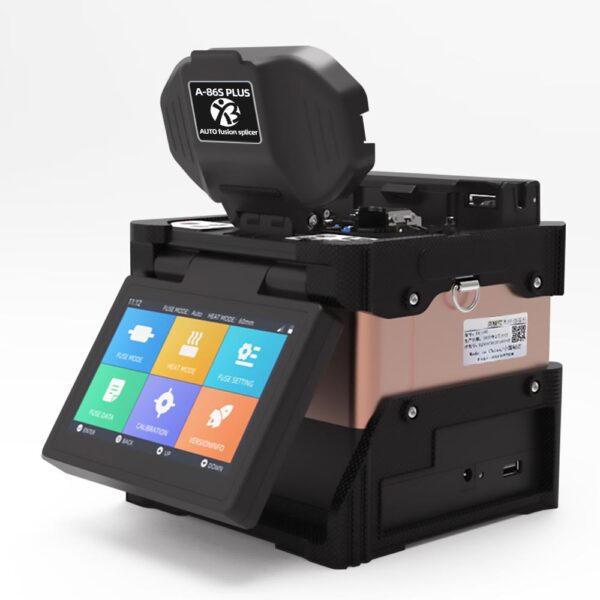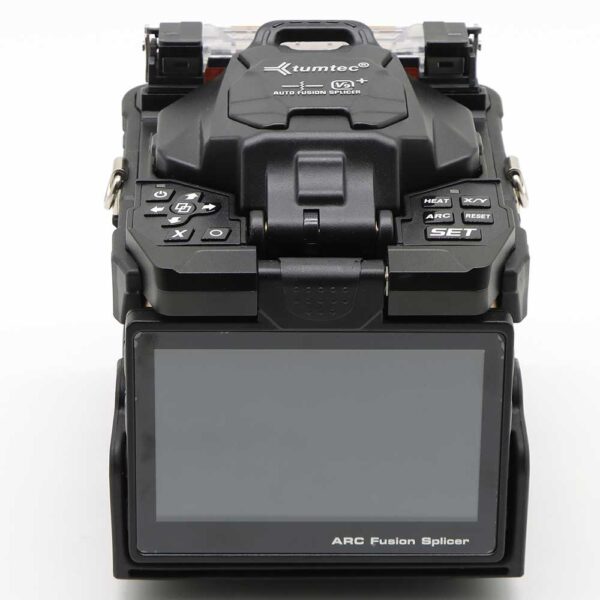Fusion Splicer
Choose the Perfect Fusion Splicer for Your Fiber Optic Project
Fusion splicing is the cornerstone of today’s fiber optic networks, providing a seamless, low-loss connection that is central to high-speed data transmission. With the advent of 5G, along with its associated increase in bandwidth capacity, there are optimistic signs of growth in industry forecasts. Choosing the right fiber jointing device will have a significant impact on project confidence and efficiency.
Showing all 8 results
A-86S Automatic Fiber Optic Splicer Kit & Fiber Cleaver Kit 4 Motors
Original price was: $550.00.$399.00Current price is: $399.00.A-86S Plus Fiber Optic Fusion Splicing Machine 6 Motors, Core Alignment 6s Splicing 5″ Touchscreen, 3in1 Fiber Holder, 7800mAh Battery for SM MM DS NZDS
Original price was: $620.00.$499.00Current price is: $499.00.Clad Alignment Fujikura 45S Fusion Splicer
Original price was: $5,200.00.$3,499.00Current price is: $3,499.00.Fujikura 90S+ Core Alignment Fusion Splicer – 7 Sec Splicing Time & Fast Heat Time with CT50 Fiber Cleaver
Original price was: $6,500.00.$5,599.00Current price is: $5,599.00.SD-9 Automatic ARC Fusion Splicer with Fiber Core Alignment, 6 Motors, 5s Fast Splicing & 11s Heating, Complete Fiber Fusion Splicer Kit
Original price was: $800.00.$660.00Current price is: $660.00.Sumitomo Q102-CA+ Core Alignment Fusion Splicer
Original price was: $16,000.00.$14,099.00Current price is: $14,099.00.Tumtec FST-18S Fiber Optic V-Groove Fusion Splicer with 4 Motors, Fast Splicing & Long Battery Life for High Precision Splicing
Original price was: $950.00.$720.00Current price is: $720.00.Tumtec V9+ HD Core Alignment Fiber Optic Fusion Splicer
Original price was: $1,600.00.$1,200.00Current price is: $1,200.00.What is a Fusion Splicer and Why It Matters
A fusion splicer is a sophisticated device that permanently joins optical fibers end to end by melting their ends together and forming a complete optical path. This joining process greatly reduces loss of signal and enhances mechanical strength at the splice location.
The importance of this process is that uninterrupted light is necessary for reliably transmitting high-speed signals through the transmission network. In addition, a high-precision fusion splicing on a fiber optic cable that has been aligned for peak quality reduces the potential for errors on the network and prolongs the time you're able to transmit the light signal. When comparing fusion splicing to mechanical splicing, where there tends to be higher insertion loss and reflectance loss, splice connections made by a fusion splicer are more stable and effective.
Using a fiber joint tool as part of the splicing process can either enhance or negatively affect the life and performance of the fiber optic cable in a telecommunications, data center, or broadband network environment.
Key Types of Fusion Splicers You Should Know
There are several types of fusion splicers to accommodate various splicing requirements, balancing accuracy, cost, and throughput.
- Core Alignment Splicers use sophisticated camera systems to precisely align fiber cores, resulting in minimal optical loss. These splicers are very popular for splicing single-mode fiber networks where accuracy is critical, such as dark fiber backbone lines or long-distance fiber applications.
- Clad Alignment Splicers orient fibers based on the alignment of the cladding surrounding the core instead of the core itself. This is a faster, cost-effective alternative that can create a weaker splice for multimode fibers, or in situations where time is more of a consideration than accuracy.
- Ribbon Fusion Splicers create simultaneous fusion at once with multiple fibers that are aligned according to the ribbon fiber configuration. In data centers or carrier networks, the increased efficiency with ribbon splicing can reduce labor time required while commissioning a higher number of fibers concurrently. They generally combine core alignment components with bulk fusion capabilities.
For more information on ribbon splicers, please see the full section below regarding ribbon splicers. Please keep in mind that the type of splicer selected will depend heavily on the type of fiber being spliced, budget considerations, and the overall size of your project.
A Comparison of Core Alignment vs Clad Alignment Fusion Splicers
Core alignment technology is particularly accurate, as it is capable of aligning the actual light-carrying cores of fibers using a multi-axis motorized positioner. Consequently, it achieves ultra-low splice losses of only about 0.02 dB, making it the splicer of choice for key network architecture.
Clad alignment devices, on the other hand, are faster and easier to operate: they align the thicker fiber cladding using V-groove holders. These devices have slightly higher average losses, about 0.05 dB; however, their speed and affordability make them a practical selection for more on-premises projects such as FTTH and local area networks.
Automatic core alignment splicers use multiple motors to adjust fiber setup tolerances and positioning within microns, while clad alignment machines only use a few motors and considerably less time and energy to get the job done. Core alignment splicers may cost considerably more than clad splicers, or a standard clad device might underperform, but for higher-stakes projects, core alignment splicers are a more reliable technology for satisfying demanding specifications. For smaller projects, or projects where speed is essential, a clad device offers a better solution.
Ribbon Fusion Splicer for High Fiber Count Projects
While not as accurate as core or clad alignment devices, ribbon fusion splicers are designed to perform mass fusion for multiple fibers placed inside a flat ribbon, with ribbons that do more than 12, 24, or even larger groups of fibers at a time. This capability allows for much faster splicing work in environments that require high fiber throughput rates from time to time, such as data centers, backbone infrastructure, and outdoor network builds.
Instead of aligning fibers to find the lowest loss, ribbon devices simply manage multiple fibers with acceptable core alignment through the entire bundle while ensuring consistent low loss and high uniformity. Ribbon splicing work is far more cost-efficient when labor rates are factored in, and ribbon devices provide acceptable integrity for both individual fibers and fibers that are bundled together.
Ribbon splicing devices are efficient when enterprise LAN deployments or telecommunications upgrades demand both speed and precision, and desired outcomes are critical. More advanced models provide automated settings, real-time estimated loss measurements, and fiber visualization while streamlining complex workflows.
Choosing Fusion Splicers Based on User Profile
Choosing the correct fusion splicer option is largely based on aligning the device capabilities with the user skill set and project requirements.
- Entry-level users can benefit the most from basic fiber splicer kits, based on ease of use with pre-stored settings, simple menu navigation, and a reasonable price for both features and fiber optic accessories.
- Field technicians care about rugged, fast-operating splicers designed to work outdoors. Features like durable designs, battery longevity, dust resistance, and multi-fiber bundled fiber splicing capabilities are critical for first-rate field productivity.
- Network managers, responsible for deployments with a large number of fibers, prioritize throughput and speed to deploy their services efficiently. Advanced core alignment models with ribbon splicing can integrate into network documentation systems and provide advanced diagnostics that improve management of large fiber deployments.
Structured user profiling improves the likelihood of purchasing the right equipment, optimizing operational productivity, and avoiding over- or under-purchasing.
Fusion Splicers for Beginners and Entry-Level Users
Beginning splicer machines are made for those who will use a splicer for the first time, offering a simple, automated, and uncomplicated method of getting trained and completing the splicing job.
The splicers in this category are usually part of a comprehensive fusion splicer kit, which is practical for transporting and has a long lifespan. It is also the easiest to work with and relatively straightforward to maintain.
A few more characteristics of splicer machines for beginners and entry-level splicers include low weight and low-drag; they don't require vigorous handling, and having a clear display interface eliminates the possibility of mistakes.
These splicer machines are functional, easy to use, while still providing strong performance and capabilities similar to more advanced splicing machines.
Advanced Fusion Splicers for Technicians and Professionals
Technicians are looking for the right combination of multi-functionality and accuracy in a fusion splice machine to get the job done quickly, with high-quality splice results. Some examples of professional brands include Fujikura and Sumitomo (to name a few), which are premium brands emphasizing integrated core alignment and ribbon capabilities, fast cycle times, and reporting features to improve efficiencies.
Their attributes also include a robust machine designed for an environment requiring extended-use durability, and it is important for technicians that the user control function is simple to learn, without a prolonged learning curve when making adjustments to the operational settings of the splicer.
Looking beyond the splicing machines, investing in a professional laminate handle further supports splice integrity, particularly for wireline and other critical data infrastructure installations.
Fusion Splicers for Network Managers and Larger Projects
High-level network managers rely on high-functioning, sophisticated systems for splicing fiber optic cables. These splicer machines are designed for volume, intelligence, and reliability. Some advanced features for splicer machines for high-level network managers include handling ribbon splicing, smart pre-programmed features such as determining fiber type, real-time loss monitoring based on reflexes, compensating for fiber environmental conditions, etc.
Data flows from a splicer machine into network management systems for tracking and product quality assurance purposes. These splicer machines also possess portability in design, and output produced by the machine can be used for project deployment across wide areas.
Smart splicing units are important when facing the demands of fiber performance levels and scale, particularly for 5G and 400G infrastructure deployments.
Key Features to Note When Looking for Splicer Machines
When considering splicer machine options for your projects, consider the following factors while understanding the specifications and outlines common for splicer machines and applying them to contractor and worksite situations:
- Automated Core Alignment: Ensures the fibers are aligned in order to minimize signal strength degradation, and is even more critical for single-mode fibers.
- User Interface: Displays; touchscreen function; simplifies operation and reduces errors during setup and prior to splicing or while in splice mode.
- Battery Efficiency: Battery life; weight is always a common complaint with any work tools, but it is important to consider battery power and functionality in the field, especially if there is a 'quick charge' feature. The internal battery should hold charges effectively, and manufacturers can add smart functionality to store splice information, project depth, etc.
- Cycle Speed: What is the overall splice time and how long does it take to set the splice joint, especially with heat shrink? Faster splicing and other functions reduce the risk of downtime, allowing for more time in the field on larger deployments.
- Durability: Dustproof, waterproof, & shockproof certifications relating to the design and operational capabilities of a fusion splicer.
- Inbuilt Diagnostics: Some splicer machines include splice loss estimation, as well as fiber identification for immediate quality checking.
- Data Management: The splicer machine will allow the operator to store the joint and related operational data via its firmware and/or software-based UI to provide evidence of compliance for future purposes.
- Price vs. Value: Evaluating needs from a risk perspective, adding critical attributes, and understanding that part of the operation/splicing may come at a higher investment value compared to cheaper options.
In evaluating these features, further outlining will help determine the optimal balance between expenditures and efficiency.
Fusion Splicer Comparison Table
| Brand & Model | Key Features | Suitable Fiber Types | Approx. Price Range | Portability |
| Fujikura 90S+ | Precision core alignment, 7-sec splice, long battery, rugged | Single-mode, Multimode, Ribbon | $8,000 - $12,000 | Moderate |
| Sumitomo Electric T-408S | Core alignment, dual fiber holder, intuitive | Single-mode, Multimode | $7,500 - $11,000 | Portable |
| Signal Fire AI-9 | Affordable, fast cycles, autofocus, VFL integrated | Single-mode, Multimode | $2,000 - $3,500 | Compact, highly portable |
| Comshine FX39 | Six-motor alignment, 6-sec splice, strong battery | Single-mode, Multimode | $3,000 - $4,500 | Lightweight |
| Fujikura 70S+ | Multifiber & ribbon, advanced UI, rapid | Single-mode, Multimode, Ribbon | $12,000 - $15,000 | Moderate |
| Sumitomo Type-81C | Ribbon splicing, auto calibration, high throughput | Ribbon (12-24 fibers) | $14,000 - $18,000 | Mostly stationary |
Notes:
- Fujikura brand units strike a balance between accuracy and support.
- Sumitomo is a ribbon-based workhorse designed for telecom applications.
- Value splicers, like Signal Fire, are designed for basic applications or small jobs.
- Ribbon splicers require more skill and setup but increase volume tremendously.
FAQ:
Can you splice fiber optic cable?
Of course! Fusion splicers are designed specifically for permanently splicing two pieces of fiber with the least amount of loss.
How much does a splice cost?
There is quite a large range in cost, but higher-end devices tend to cost less per splice because of their speed and accuracy.
Is it possible to rent fusion splicers?
Yes. Renting is an option for short projects or tests and can be a good way to save money. In general, higher-end devices are an option for regular applications.
How is a fusion splicer maintained?
Cleaning, performing electrode calibrations, and servicing by a professional are required for optimal performance and longevity.
Keeping Up with the Latest Fusion Splicing Technologies
With the advent of new standards for fiber networks, primarily 5G and 400G, we will see the introduction of new tools to join fibers, aided by AI, core alignment, and automated hints and guidance for users. This will provide better splicing accuracy and reduce operator fatigue.
The development of better batteries and wireless communications will greatly increase working time and data capacity.
Diagnostics and reporting based on cloud services will also be introduced, allowing users to share and report fiber splicing quality and fiber faults at the time of installation for maintenance and preemptive maintenance plans.
Full automation, additional multi-fiber capacity, and smart analytics will all be hot topics.
Adopting newer fiber joining tools will future-proof your job and improve the reliability of your network.








